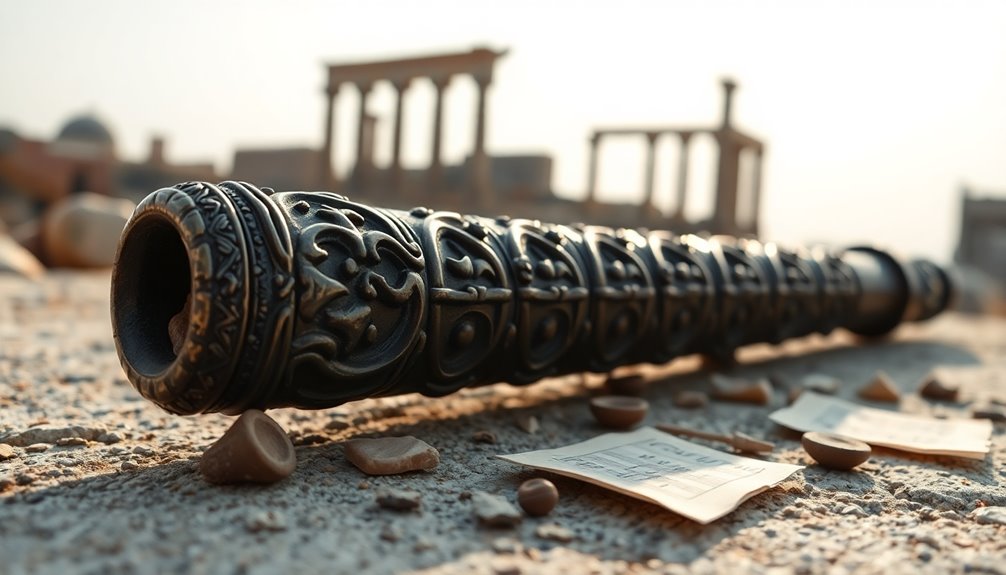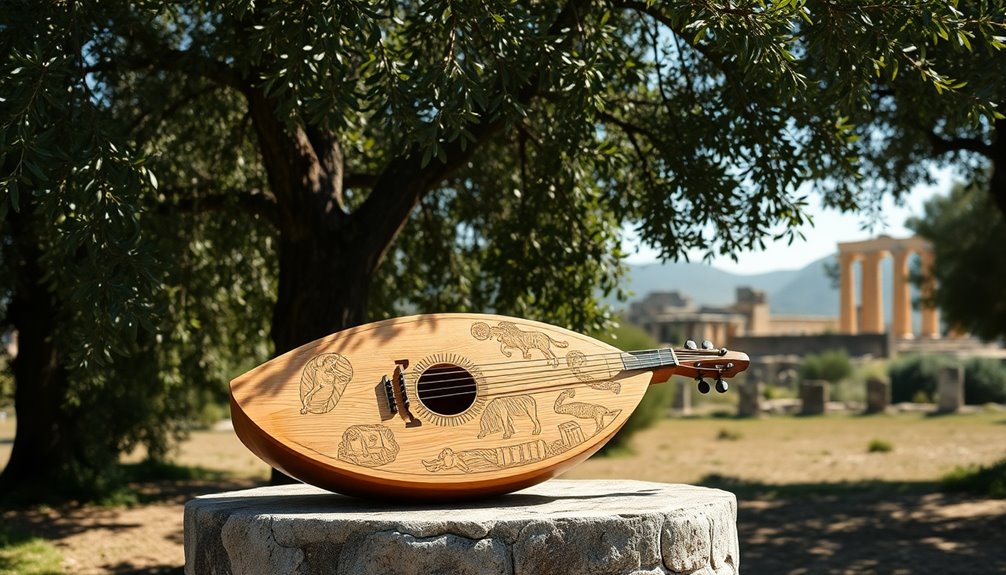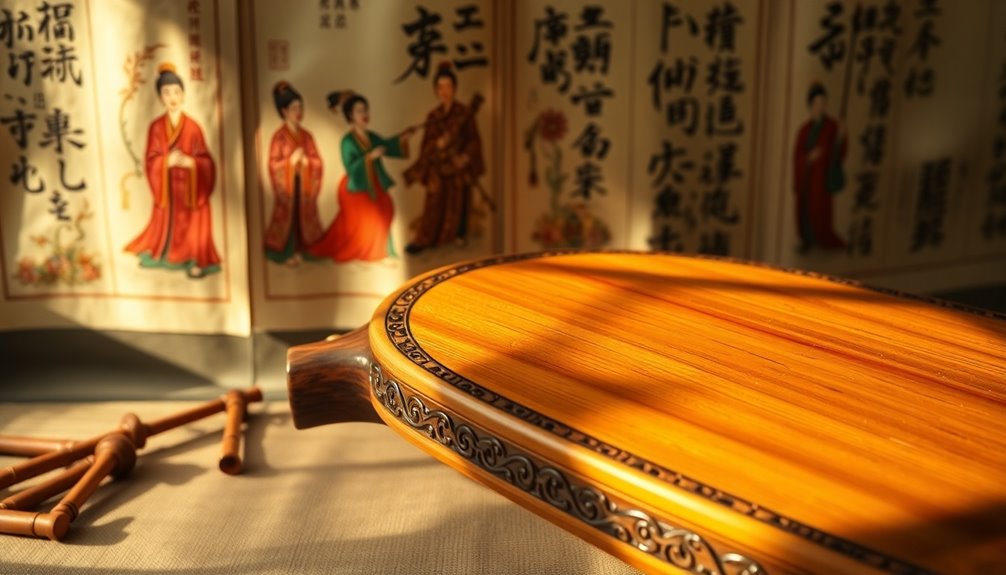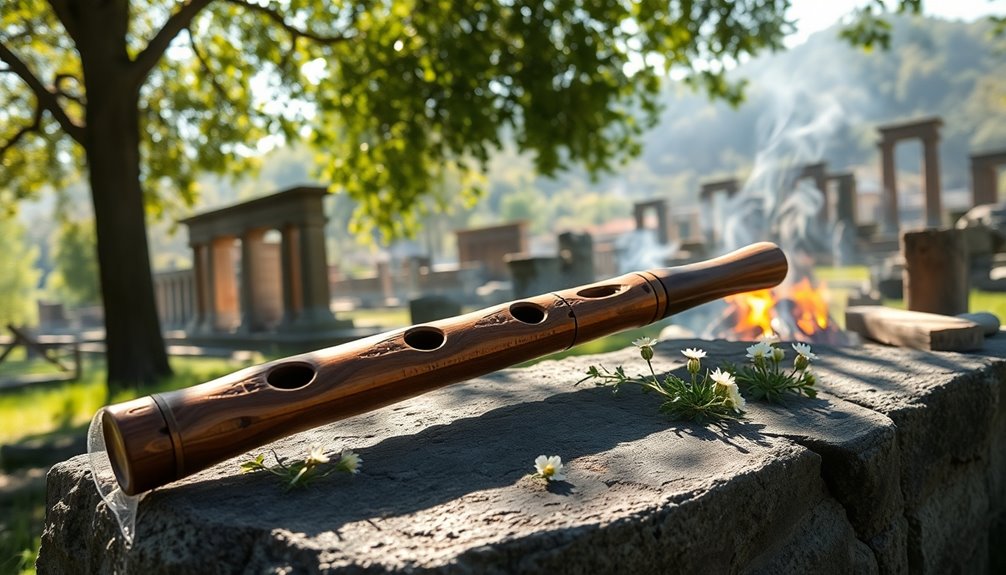Wind instruments played a significant role in ancient civilizations, acting as more than mere musical tools; they were essential for rituals, communication, and community bonding. Flutes, made from materials like bone and wood, held deep cultural significance in societies such as Ancient Egypt, where they enhanced religious ceremonies. The Greek aulos and Native American flutes served as conduits for spiritual expression, while Roman pan flutes fostered social cohesion during festivities. These instruments were often intricately crafted, linking artisans to the divine. Understanding their legacy reveals rich cultural narratives that continue to resonate in today's music. There's so much more to explore.
Key Takeaways
- Wind instruments, like flutes, played vital roles in ancient civilizations for communication, celebration, and storytelling, enhancing cultural expression.
- Ancient Egyptians used flutes in religious rituals to create an atmosphere connecting communities and the divine.
- Native American flutes served as spiritual expressions, reflecting diverse cultural practices and connections to nature among tribes.
- The Greek Aulos was significant in both sacred and secular contexts, integral to ceremonies, theater, and social gatherings.
- Roman Pan Flutes, or "tibiae," enhanced community cohesion during festivals, fostering unity through music in communal celebrations.
Overview of Wind Instruments

Wind instruments, often considered an essential part of ancient musical traditions, played a significant role in cultural expression and social rituals. When you investigate these instruments, you discover their historical significance and the deep cultural symbolism they carried across various civilizations.
From the haunting melodies of the ancient Greek aulos to the powerful blasts of the Roman cornu, each wind instrument served not just as a tool for music but also as a means of communication, celebration, and storytelling.
In many societies, wind instruments were integral to religious ceremonies, signifying connection to the divine. For instance, the sound of a shofar in Jewish tradition heralds important events, while Native American flutes are often associated with spiritual healing and connection to nature.
You can see how these instruments became symbols of unity and identity, representing the values and beliefs of the communities that played them.
Moreover, the craftsmanship behind these instruments reflects the cultural practices and materials available in ancient times. Whether fashioned from wood, bone, or metal, each wind instrument tells a story of the people who created and used it.
By understanding their context, you can appreciate how these instruments influenced social dynamics, rituals, and even warfare. Additionally, the various types of flutes, like the Western Concert Flute, showcase the diversity within wind instruments across cultures and eras.
As you explore deeper into the world of ancient wind instruments, you'll find that they're more than just musical devices; they're a lens through which to view the heart and soul of ancient civilizations, binding communities together through sound and tradition.
Origins of Flute Instruments

Flute instruments have a rich history that dates back thousands of years, with some of the earliest known examples originating from ancient cultures across the globe. The flute's simplicity and accessibility have made it a beloved instrument in various civilizations. You might find it fascinating to investigate how these early flutes were crafted and what they signify in their respective cultures.
- Materials Used: Early flutes were made from materials like bone, wood, and even reeds. These natural resources shaped the sound and character of the instruments, reflecting the environment of the players.
- Cultural Significance: In ancient cultures, flutes often held ceremonial importance. They were used in rituals, celebrations, and communal gatherings, creating a sense of unity among people.
- Evolution of Design: The evolution in flute design showcases a blend of artistry and functionality. From simple, straight tubes to more intricate, multi-toned structures, this evolution mirrors advancements in musical expression and cultural exchange. The diverse types of flutes, such as the Concert Flute, highlight the instrument's versatility and adaptability over time.
As you investigate deeper into flute history, you'll notice that these instruments serve as a bridge connecting us to the past.
They offer insights into the lives, beliefs, and artistic expressions of ancient cultures. By appreciating the origins of flute instruments, you can feel a sense of belonging to a broader narrative that celebrates human creativity and connection through music.
Flutes in Ancient Egypt

Music played an essential role in the cultural and spiritual life of ancient Egypt, with flutes serving as prominent instruments in both everyday and ceremonial contexts. You'll find that ancient Egyptian music, characterized by its melodic and rhythmic complexity, often featured flutes made from materials like reed or wood.
These instruments weren't just for entertainment; they were integral to religious rituals and celebrations, enhancing the atmosphere and connecting the community with the divine.
Flutes in ancient Egypt varied in design and size, allowing musicians to produce a range of tones and pitches. The sound of the flute held deep cultural significance, often associated with the goddess Hathor, who represented music, dance, and joy. This connection illustrates how music, particularly from flutes, functioned as a bridge between the earthly domain and the spiritual world.
When you explore the role of flutes further, you'll see they were used in various settings—from lively festivals to solemn funerals. They accompanied dancers and storytellers, creating a sense of unity among participants.
This communal experience underscored the importance of social bonds within ancient Egyptian society.
In essence, flutes were more than mere instruments; they encapsulated the essence of ancient Egyptian music and its cultural significance. By engaging with these beautiful sounds, you're tapping into a rich heritage that valued both artistic expression and spiritual connection, reminding us of the lasting power of music in shaping community and identity. Additionally, the structured nature of flute music in ancient Egypt reflects a methodical progression that can be seen in modern flute lesson approaches, emphasizing the importance of clear musical instruction.
Greek Aulos and Its Influence

Following the rich tradition of ancient wind instruments, the Greek aulos emerged as a prominent and influential musical device in classical antiquity. This double-reeded instrument, often associated with both sacred and secular music, played a crucial role in various cultural contexts.
By understanding the aulos construction and its performance, you can appreciate its significant impact on music history.
The aulos was typically made from materials like wood, cane, or even metal, featuring a pair of pipes that produced a unique, vibrant sound. Its construction allowed for a remarkable range of tones, making it suitable for diverse musical expressions.
In performance, aulus players often showcased their skill, blending intricate melodies with rhythmic accompaniments.
To better grasp the influence of the aulos, consider these key aspects:
- Cultural Significance: The aulos was integral to religious ceremonies, theatrical performances, and social gatherings, enriching the cultural fabric of ancient Greece.
- Musical Versatility: Its ability to produce both melody and harmony enabled it to accompany vocalists and other instruments, establishing a dynamic interplay in ensembles.
- Legacy in Music: The aulos inspired later woodwind instruments, influencing the development of modern wind music, and leaving a lasting mark on the evolution of musical styles. Additionally, the aulos shares similarities with members of the flute family, which highlights its significance in the lineage of wind instruments.
Native American Flute Traditions

Throughout history, numerous Native American cultures have embraced the flute as an essential instrument in their musical traditions. The flute serves not just as a musical tool but as a conduit for spiritual expression and connection to the natural world. Its soothing melodies resonate with the echoes of the Earth, embodying flute symbolism that conveys emotions ranging from love to longing.
You'll notice that the Native American flute varies in design and function across different tribes. Each community has its unique style, often using local materials like wood or bone to craft beautifully intricate flutes. The sound produced is intimately linked to the natural environment, often reflecting the sounds of wind, water, and animal calls.
This deep connection to nature is a hallmark of Native American culture, where music acts as a bridge between the physical and spiritual dimensions.
In many traditions, the flute is considered a "healing" instrument. It's used in ceremonies to promote emotional well-being and spiritual growth. You might find that songs played on the flute often accompany storytelling, rituals, and social gatherings, fostering a sense of belonging within the community. Additionally, the choice of high-quality woods in flute construction influences both the sound quality and durability of the instrument.
As you explore these traditions, you'll discover that the Native American flute is more than just an instrument; it's a symbol of cultural identity and continuity. It invites listeners to reflect on their own relationships with nature and each other, weaving a rich tapestry of connection through sound.
Chinese Dizi and Its Evolution

The Chinese dizi, a bamboo flute with a rich history spanning thousands of years, showcases an intricate interplay between cultural tradition and musical evolution. Its construction typically involves selecting high-quality bamboo, which is meticulously crafted into a cylindrical shape, often featuring six finger holes and a unique membrane that enhances its sound. This careful craftsmanship not only affects the dizi's acoustics but also reflects the artistry passed down through generations.
The dizi holds significant cultural importance in Chinese music, often associated with folk traditions and classical compositions. As you explore its evolution, consider the following aspects:
- Historical Development: The dizi has been used in various dynasties, adapting to the tastes and styles of each era while retaining its core identity. Its presence in ritualistic and celebratory contexts highlights its communal role.
- Regional Variations: Different regions in China have developed their own styles of playing the dizi, introducing variations in construction and technique. This diversity enriches the overall musical landscape.
- Modern Adaptations: Contemporary composers and musicians are integrating the dizi into modern genres, bridging traditional Chinese music with global influences. This evolution invites you to appreciate the dizi's relevance today. Additionally, the choice of bamboo age significantly impacts the dizi's sound quality, enhancing its tonal richness and depth.
In understanding the dizi's construction and cultural significance, you gain insight into how this ancient instrument continues to resonate, fostering a shared sense of belonging among those who play and listen.
Roman Pan Flutes and Their Use

Harmony emerges from the ancient Roman pan flute, known as the "tibiae," which captures the core of communal music-making in Roman society. This instrument, often crafted from reeds or wood, consists of multiple pipes of varying lengths, allowing for a range of notes that create a rich tapestry of sound.
In Roman music, the pan flute played a crucial role, not merely as an entertainment piece but as a means of social cohesion, bringing people together during festivals, religious ceremonies, and public gatherings.
As you explore the world of Roman pan flutes, you'll discover their significance in both urban and rural settings. Musicians would often perform in pairs or groups, enhancing the communal experience. The harmonious blend of melodies reflected the unity of the community, resonating with the joys and sorrows of daily life.
The tibiae's music could evoke feelings of nostalgia, celebration, or even somber reflection, demonstrating its versatility and emotional depth. Additionally, the intricate flute family of instruments contributes to the diverse soundscapes found in various musical traditions.
Moreover, the use of the pan flute in theater and storytelling further underscored its importance in Roman culture. The sounds produced by the tibiae would amplify the narrative, drawing audiences into the performance.
Essentially, the Roman pan flute was more than an instrument; it was a vessel of connection, weaving together the threads of Roman life. Through the enchanting notes of the tibiae, you can feel the pulse of a society that cherished shared experiences and the power of music to forge bonds.
Flute Craftsmanship in Ancient Cultures

Ancient cultures across the globe demonstrated remarkable skill in flute craftsmanship, creating instruments that weren't only functional but also deeply symbolic. The artistry behind these flutes reveals much about the societies that produced them, reflecting their values, beliefs, and the materials available to them.
By examining flute craftsmanship, you can appreciate the intricate relationship between music and culture.
Here are three key aspects of flute craftsmanship in ancient cultures:
- Flute Materials: Ancient artisans used a variety of materials, such as bamboo, wood, bone, and metal. Each material contributed unique tonal qualities, allowing for a diverse range of sounds. The choice of material often reflected local resources and traditions.
- Cultural Significance: Flutes weren't just musical instruments; they held profound cultural implications. In many societies, flutes were associated with spiritual rituals, storytelling, and communal gatherings. Crafting a flute was often seen as a sacred act, linking the maker to the divine.
- Design and Ornamentation: Flutes came in various designs, often adorned with carvings or paintings that conveyed cultural narratives. These embellishments added a layer of meaning, showcasing the flute not only as a tool for music but also as a canvas for artistry and identity.
Additionally, some ancient flutes, such as the Wooden Flute Piccolo, were designed in lightweight forms to promote ease of use and accessibility for beginner musicians, enhancing musical education within communities.
Understanding flute craftsmanship allows you to connect with ancient cultures on a deeper level, revealing how music served as a unifying force that resonated through time and continues to inspire today.
Musical Roles of Flutes in Society

Flutes played multifaceted roles in societies, transcending mere entertainment to become essential elements of social structure and cultural identity. In many ancient civilizations, the flute wasn't just an instrument; it served as a conduit for communal expression and spiritual connection. Its melodic tones often filled the air during significant events, marking the rhythm of life itself.
Consider how flutes were integral to social gatherings. Whether at festivals, weddings, or harvest celebrations, their music fostered a sense of unity among participants. The act of playing and listening to flute music created an atmosphere where individuals could connect, share stories, and celebrate heritage.
You'd find that communities often relied on these gatherings to strengthen bonds and reinforce cultural narratives, with flutes playing a central role in this dynamic.
Moreover, flutes carried ceremonial significance, often used in rituals that connected the living with the spiritual dimension. In many cultures, they were believed to channel the voices of ancestors, aiding in communication with the divine.
This sacred aspect of flute music added depth to its role within society, as it intertwined personal, communal, and spiritual identities. Traditional flute melodies serve as a rich source for creative inspiration, reflecting the history and emotions of the communities that created them.
In essence, the flute was much more than a musical instrument; it was a symbol of belonging and identity, weaving together the threads of community life. By understanding its roles in ancient societies, you can appreciate how music fosters connections that continue to resonate through time, echoing the shared human experience.
Legacy of Ancient Flutes Today

It's fascinating to see how the legacy of ancient flutes continues to shape contemporary music and cultural practices. The evolution from ancient designs to the modern flute showcases not just technological advancements, but also a deep-rooted cultural significance that resonates today.
When you explore the impact of these instruments, you uncover layers of history and community that invite you to connect with the past.
Here are three key areas where the legacy of ancient flutes is evident:
- Musical Styles: Many contemporary genres, from folk to classical, still utilize flute techniques derived from ancient traditions. You'll notice that the breath control and ornamentation techniques have roots tracing back thousands of years.
- Cultural Rituals: Flutes often play a central role in cultural ceremonies around the world. Today, you might find modern flutes employed in spiritual gatherings, much like their ancient counterparts were used to invoke feelings of connection and unity.
- Education and Preservation: Many music educators emphasize the historical significance of the flute in their curricula. By teaching students about ancient flutes, they foster a sense of belonging to a larger musical heritage, encouraging appreciation for cultural diversity. Additionally, understanding the importance of embouchure is crucial for mastering modern flute techniques, which can further connect students to the traditions of ancient flutists.
In recognizing these connections, you not only honor the legacy of ancient flutes but also understand their lasting influence on modern music, allowing for a richer cultural experience.
Frequently Asked Questions
What Materials Were Used to Make Ancient Wind Instruments?
When you explore the materials used for ancient wind instruments, you'll find that bamboo flutes and animal horns were prevalent choices.
Bamboo, lightweight and easily worked, produced clear, resonant tones, making it ideal for flutes.
Animal horns, on the other hand, offered a robust sound and durability.
How Were Ancient Wind Instruments Played Differently Than Today?
When you think about the way people once expressed themselves through music, you'll notice that ancient wind instruments were played with a unique flair.
The playing techniques varied widely, often reflecting cultural variations. For instance, breath control and embouchure were pivotal, with musicians using their whole bodies to create sound.
Unlike today, where standardization reigns, these early artists embraced personal styles, making their music a truly communal experience, rich in tradition and creativity.
Did Ancient Civilizations Have Specific Scales for Their Wind Instruments?
Yes, ancient civilizations often used specific scales for their wind instruments, reflecting their cultural significance.
You'd find that musical notation varied widely, serving not just as a method of recording music but also as a means of preserving cultural identity.
These scales didn't just dictate pitch; they embodied communal values and traditions.
Understanding these scales can deepen your appreciation for how music connected people, shaping their societies and rituals in profound ways.
Were Wind Instruments Used in Religious Ceremonies in Ancient Cultures?
Isn't it ironic that something as simple as blowing into a tube could hold such ritual significance?
In ancient cultures, wind instruments played pivotal roles in religious ceremonies, serving as conduits between the divine and the earthly. Their cultural symbolism often underscored the importance of sound in worship, enhancing spiritual experiences.
You'd find these instruments not just as tools, but as sacred objects shaping communal identity and fostering a sense of belonging among participants.
How Did Trade Influence the Design of Wind Instruments?
Trade greatly influenced the design of wind instruments through cultural exchange, allowing diverse techniques and materials to merge.
As you explore the interactions between different societies, you'll see how artisans adopted and adapted foreign designs, leading to design evolution.
For instance, a woodwind from one culture might incorporate the shape or embellishments from another, creating unique instruments that reflect a shared heritage.
Ultimately, this process enriches your understanding of music's interconnected history.
Conclusion
Ancient wind instruments, like the delicate flutes of Egypt and the robust aulos of Greece, showcase a rich tapestry of cultural expression. While these instruments once filled sacred spaces with haunting melodies, today, they serve as symbols of historical continuity and innovation. The craftsmanship behind each flute tells a story of human ingenuity, connecting past and present. As you listen to modern interpretations of these ancient sounds, you'll find echoes of tradition breathing life into contemporary music.






